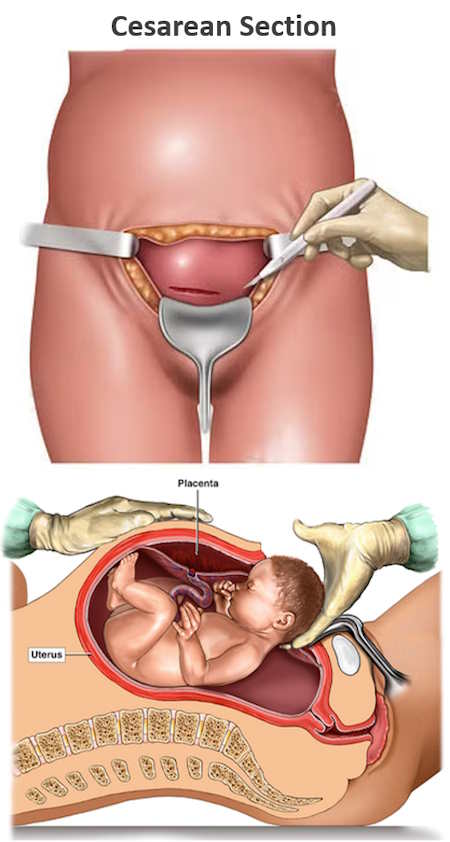C-Section (Cesarean Section) Operation, Risks & Recovery
What is a Cesarean Delivery?

A Cesarean delivery, commonly known as a C-section, is a surgical procedure used to deliver a baby. During this procedure, an incision is made in the mother’s abdomen and uterus to safely deliver the baby. According to the National Center for Health Statistics, approximately 1 in 3 babies in the United States are delivered through a C-section. In Pakistan, the rate is also increasing due to various medical and personal factors. If you undergo a C-section, anesthesia will be administered so you do not feel pain during the procedure.
Why Might You Need a C-Section?
You may know ahead of time if you need a C-section, but it can also be decided during labor. Common reasons for scheduling a C-section include:
- A previous cesarean delivery.
- The baby is not positioned head-first (breech or transverse).
- The baby is larger than average (macrosomia).
- The mother has certain infections, such as herpes or HIV, which can be transmitted to the baby during vaginal birth.
- The mother has placenta previa, where the placenta is covering the cervix, preventing a safe vaginal delivery.
- Medical conditions or abnormalities in the baby that make a vaginal delivery unsafe.
Some women choose to have a C-section even when it’s not medically necessary. If you’re considering this option, it’s crucial to discuss the potential risks with your doctor.
When Should a Planned C-Section Take Place?
Most planned C-sections are scheduled for the 39th week of pregnancy or later. This ensures that the baby has had enough time to fully develop before birth, reducing the risk of complications such as breathing difficulties in the newborn.
Why Some C-Sections Happen After Labor Begins
A C-section may become necessary after labor begins due to:
- Labor progressing too slowly, with contractions not strong enough to move the baby down the birth canal.
- A baby that is too large for the mother’s pelvis, preventing a safe vaginal birth.
- The baby being in an abnormal position, such as feet or buttocks first (breech).
In some cases, the health of the baby or mother may be in immediate danger, such as when the baby’s heart rate drops or the mother experiences excessive bleeding. In these situations, a C-section is often the fastest and safest option.
Will I Need a C-Section If My Labor Is Slow?
Not necessarily. If your labor is slow, your doctor may administer oxytocin to strengthen contractions. If this doesn’t help after a few hours, your healthcare provider may then suggest a C-section. It’s important to discuss your options thoroughly with your medical team if your labor is progressing slower than expected.
How Is a C-Section Performed?
Here is an overview of how a C-section is typically performed:

c section operation, best gynecologist lahore
- Anesthesia: You will receive anesthesia to ensure you don’t feel pain. There are two types commonly used: regional anesthesia (such as an epidural or spinal block), where you remain awake, or general anesthesia, where you are asleep during the procedure.
- Incision: The doctor will make an incision in your lower abdomen. Most often, this is a horizontal cut made just above the pubic area. In emergency situations, a vertical incision might be made for quicker access.
- Delivery: After the incision, the doctor will carefully open the uterus and deliver the baby. The umbilical cord is then cut, and the placenta is removed.
- Closing the Incision: Finally, the doctor will stitch or staple the uterus and the abdominal incisions.
The entire procedure typically lasts about 45 minutes to an hour.
What Is Recovery Like After a C-Section?
Recovery from a C-section can take time. In the hours following surgery, you’ll be encouraged to start moving, which helps prevent blood clots. Most women stay in the hospital for 3 to 4 days after a C-section. Full recovery usually takes about 6 weeks, but it can vary depending on individual circumstances.
It’s normal to experience pain at the incision site, along with some abdominal discomfort and vaginal bleeding, for a few weeks after the surgery. Many women find that they can return to work or their usual activities after 6 weeks.
What Are the Risks Associated with a C-Section?
While C-sections are generally safe, there are some risks involved, including:
- Injury to nearby organs such as the bladder or intestines.
- Infections at the incision site.
- Blood clots, which can cause complications such as pulmonary embolism.
- Delayed bonding between mother and baby immediately after birth.
- A longer recovery period compared to vaginal birth.
- Potential complications with the placenta or uterus in future pregnancies.
- Breathing problems for the newborn, although these typically resolve quickly.
It’s essential to weigh the benefits and risks of a C-section with your doctor, who can guide you based on your specific circumstances.
What to Expect During Recovery
During the first few weeks of recovery, you may experience:
- Mild to moderate cramping in the abdomen.
- Vaginal bleeding and discharge, which is normal and should decrease over time.
- Discomfort around the incision site.
It’s important to follow your doctor’s post-surgery care instructions. You should contact your healthcare provider if you experience:
- A fever higher than 100.4°F (38°C).
- Increased pain or redness at the incision site.
- Heavy vaginal bleeding or unusual discharge.
These symptoms could indicate an infection or other complications, and prompt medical attention is necessary.
Can I Have a Vaginal Birth After a C-Section?
It is possible to have a vaginal birth after a previous C-section (often referred to as VBAC – Vaginal Birth After Cesarean). However, it depends on factors such as the reason for your initial C-section, your health, and your baby’s condition. It’s essential to discuss with your doctor whether VBAC is a safe option for you.
Generally, women who have had one previous C-section have a good chance of delivering vaginally, but after two or more C-sections, the risks increase significantly, especially related to uterine rupture. You should consider the size of the family you want, as multiple C-sections can carry serious health risks.
FAQs About C-Sections
Is a C-section painful?
With anesthesia, you won’t feel pain during the procedure, although you may feel some pressure. After the surgery, discomfort at the incision site is common, but pain relief medications are typically provided to manage this.
Can I breastfeed after a C-section?
Yes, you can begin breastfeeding shortly after the surgery, though some mothers may find it a bit more challenging due to the incision. Lactation consultants or nurses can help you find a comfortable breastfeeding position.
How long should I wait before getting pregnant again after a C-section?
It’s generally recommended to wait at least 18 months before getting pregnant again after a C-section to allow your body to heal fully. However, your doctor can provide personalized advice based on your health.
Conclusion
A C-section is a common and often necessary procedure for safely delivering a baby when vaginal birth poses risks to the mother or child. While it comes with some risks, proper care and guidance from your healthcare provider can help ensure a safe delivery and smooth recovery. If you’re preparing for a C-section or considering one, speak with your doctor to understand the procedure, its risks, and what you can expect during recovery.






